Introduction
When we look up at the night sky, we see stars amongst a sea of black. At a time when the standard model of the universe was both infinitely large and old, a man named Heinrich Olbers wondered why the sky wasn’t a sea of white starlight.
Who was this Olbers guy, anyways?

Heinrich Wilhelm Matthäus Olbers was born October 11 1758. He was a german physician by day and astronomer by night (still german, that didn’t change). He searched for planets between Mars and Jupiter, and discovered several asteroids. Olbers also hypothesized that the reason a comet’s tail was always opposite to the sun was because of the sun’s radiation pressure. He was ahead of his time in this respect — radiation pressure from light wouldn’t be discovered until about a hundred years later.
What is Olbers Paradox-ing about?
His work most relevant to this article’s interests came in the form of Olbers’ paradox. Namely, if the universe is infinite and populated with stars in all directions, why isn’t the night sky bright like a star everywhere, with no black gaps of nothingness in between? Edgar Allan Poe (yes, that one) phrased it quite nicely:
Were the succession of stars endless, then the background of the sky would present us a uniform luminosity, like that displayed by the Galaxy – since there could be absolutely no point, in all that background, at which would not exist a star. The only mode, therefore, in which, under such a state of affairs, we could comprehend the voids which our telescopes find in innumerable directions, would be by supposing the distance of the invisible background so immense that no ray from it has yet been able to reach us at all.
– Edgar Allen Poe, Eureka (1848)
Olbers was not the first to recognize this issue it’d been considered every now and again for at least a few centuries by Olbers’ time.
So, let’s do this, let’s picture an unchanging universe that is infinitely old and infinitely large with an infinite number of stars distributed throughout it. Look at this gorgeously basic diagram of Olber’s Paradox:
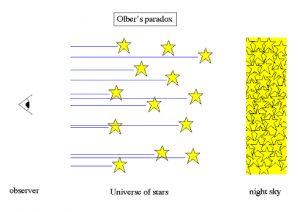
(I love it so much, pro-rated aesthetic, amirite?)
Why ‘Paradox’ is False Advertising Nowadays
Why is the night sky dark? We can’t say there’s too much cosmic dust in the way, because the stars would heat the dust until it was bright enough it may just as well be a star. Maybe the stars are set up really weird in radial lines heading out, so we can only see the closest in the line? Well, first of all that’d be really weird, make our position in the universe special, violating the Coppernican principle, and not in league with our observations. What if one of our assumptions was wrong then? Maybe there isn’t an infinite number of stars but the universe is infinitely old and phat. Not strictly impossible, but even without infinite stars, we should have light from more than enough stars to make the night sky bright. As it turns out, and this is wild, fasten your seatbelts folks, but the universe is not infinitely old! It’s a weenie 13.8 billion year old baby! Furthermore, the universe is expanding, so it’s possible the light from distant stars could be red-shifted enough to be too dim to pick up (more on red-shifting later).
The Universe Will Eventually Deserve a Cosmic Speeding Ticket
It’s worth noting that, since the current expansion of space at an accelerating rate, it’s pretty fair to call the universe infinite in scope. This expansion stretches the space in between objects that aren’t gravitationally bound, so it’s more like pulling on spandex than rolling out a carpet of new astral material. And, it’s possible that the expansion of space will eventually accelerate faster than the speed of light, so some very distant stars’ light may never reach us.
| FUN FACT Yeah, you read me right, faster than the speed of light. Einstein’s general relativity has a loophole, y’see, since the speed of light is the fastest something can travel between two benchmarks. But there’s no limit on the very fabric of space changing the places of those benchmarks faster than light can travel. Neat, huh? |
Wonderful! We have a solution to the posed paradox, so why bring it up? Well, even if the universe isn’t infinite in the same way we once supposed it was, there is a way in which the night sky is evenly bright: the Cosmic Microwave Background (CMB). We just can’t see it with our weak, pathetic little human eyes!
The CMB’s ~Hot~ Backstory
Way back when the universe was very hot and dense, photons, particles of light, and baryons, which make up the matter that we are most familiar with, would have been combined in a hot plasma. Once the universe cooled enough, the photons would have ‘decoupled’ from the plasma to forge their own paths through the universe, having a wavelength correlating to the temperature of the plasma they just broke free of.
When this decoupling occurred, these photons were in the ultraviolet range of the electromagnetic spectrum. As the universe expanded, the wavelength of these waves extended, becoming the microwaves we’re familiar with today.
But hey, look at this chart of wavelengths:
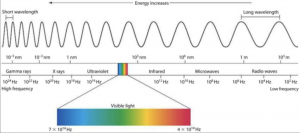
The highest energy waves are gamma rays and the lowest energy waves are radio waves. The CMB started out in the ultraviolet and ended up in the microwave spectrum. You know what that means (and if you don’t, don’t worry, I’m about to tell you)! The CMB was composed of visible light at one point, and was the Cosmic Visible Background (CVB). In order to conceptualize the CVB, let’s look more at the CMB.
What the CMB Looks Like with Makeup On
All the following images in this section are temperature maps of the space around us. Keep in mind these are depicted in the visible range as a temperature map, and that the CMB isn’t actually these colours. In the Figure 4, red is hot and blue is cool:
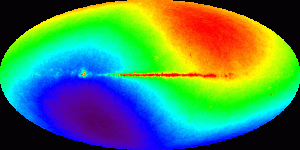
The ‘dipole’ (the yin-yang-sign-looking thing) is created by our movement through space. Blue would be away from where we were, our motion red-shifting the wavelengths, and red’d be in front of us, blue-shifting our wavelengths. Since someone decided blue would be cool instead of hot in this graph we get this not-at-all-confusing setup. Let’s go a little more into what this kind of ‘shifting’ means:
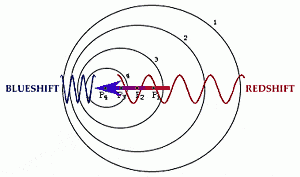
So as we move through the universe on our little spaceship Earth, the CMB we’re moving into is blue-shifted and the CMB we’re moving away from is redshifted.
Now, in the following diagram, they have blue and purple tones as hot and red tones as cold (far more sensible, in my estimation):
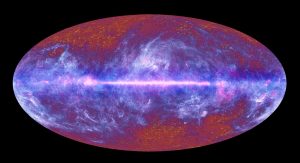
That line across the middle is the rest of the milky way galaxy, filled with plenty of hot stars and gasses.
This last one (Figure 7) is the actual CMB:
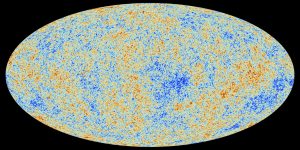
So we wouldn’t see this one, it’s just a depiction of the CMB’s actual state of affairs. Notice how the colours aren’t uniform? Some are more common and less common, based on temperature. If you find all this interesting, my colleague Alex Rosset has a page which goes into more detail about the CMB. Link here! Check it out, but only once you’re finished appreciating my page, of course!
What the CMB Looks Like Without Makeup On

Just… a peaceful body of black… That reminds me, in a completely uncontrived way, of the relevance of the fact that the CMB is a ‘blackbody’.
*Sigh* What’s a Blackbody, Then? And Why’s it Relevant?
A blackbody absorbs all the EM radiation (light, visible and not) coming at it. If all the light is absorbed, none remains, so the object is black.
But, even a blackbody wants to be the same temperature as its surroundings, so it has to emit energy as well. Blackbodies only emit energies with certain characteristics, namely, they emit a curve of wavelengths, with some more likely to occur and occurring in greater quantities than others. If you look at this graph of the blackbody emission spectrum:
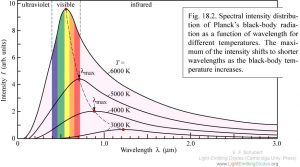
So, at 6000 Kelvin, Visible yellow light appears to be the peak wavelength, but there would also be plenty of red, and not as much purple, present.
What Kinds of Things are Blackbodies?
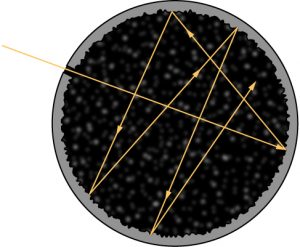
The standard example of a blackbody would be a cavity with a tiny entrance and black interior walls, so all the light coming in gets absorbed before it can reflect back out.
But even if we think of that, it’s imperfect. It’s a good black body, not a perfect one. Stars are also pretty good black bodies, but they emit more or less of certain colours based on what chemical elements are present in the star.
We’ve also made pretty good blackbodies, Vantablack is a material made up of Vertically Aligned Nanotube Arrays (hence ‘vanta’black) that absorbs 99.96% of the light incident on it.
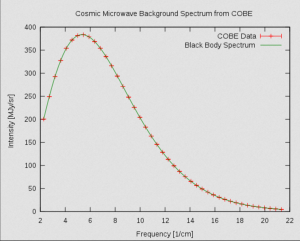
The cosmic microwave background is considered the most ideal black body we’ve observed to this point (I’m not sure if the ones we’ve made are better or not).
It’s theorized that black holes might be perfect (or virtually perfect) black bodies, but we haven’t observed the predicted radiation they’d emit, called Hawking radiation.
So, What Would the CVB Look Like?
Among the colours we can see, purple has the highest energy photons, and red the lowest energy photons. So picture this. You’re living your daily life, and over a period of time, the sky gets purpler and purpler at night. But not perfectly, recall figure 9 (if not, scroll up), there’d be a range of visible colours? See? The section had an important purpose after all: fortifying your imagination! (I swear I’m a scientist) It’d also have tiny deviations, places where it’s hotter than average, places where its cooler than average, a la figure 7. So we get some variety! The sky’d get purpler and purpler, and by the time it was a vivid violet at night, you’d be able to see some blues as well, the odd green, possibly even a daring yellow in a few places, in a pattern similar to the image of the CMB before.
And slowly, over time, the colours would shift to mostly blue with some purples, greens, the odd yellows, and a few specks of irreverent orange, and so on. And as the CVB faded and became the Cosmic Infrared Background (the step before the CMB) the last we’d see is a red sky slowly fade back to black.
This is pretty cool, right? Problem is, it happened approximately 20,000 years to around 3,000,000 years after the big bang when the last hints of red would have faded away. Furthermore, after 70,000 years the reddest time would have passed, and the colour saturation would be on the downswing for the rest of that time. So the peak colour eras would have been far too hot to handle, and after that, well, it’d be hotter than the surface of Venus and still long before stars started to form. So if you took your time machine to period of bright colour, between 20,000 to 70,000 years after the big bang, to view the beautiful CVB, you’d wanna have the best heat-shielding imaginable.
Conclusion
Nonetheless, it’s cool to imagine, far off, on a distant planet, a race of aliens that looks up at night and sees nothing but bright microwave light. And perhaps the potential Alien Heinrich Olbers never forms Alien Olber’s paradox. For all the wrong reasons, of course. Perhaps, scientifically speaking, we’re lucky to get a dark blanket with pinprick stars at night, instead of something like this:
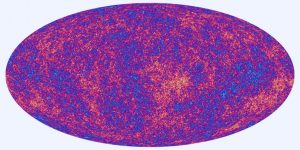
But eh, just between you and me, dear reader, I’d be inclined to go for the lovely sea of colours!
[expand title=”trigger text”]
To see the image sources, click on the blue ‘Show more’ text
Figure 1: Olbers, detail from an engraving, Encyclopædia Britannica, https://www.britannica.com/biography/Wilhelm-Olbers#/media/1/426720/30472
Figure 2: http://abyss.uoregon.edu/~js/ast123/lectures/lec15.html
Figure 3: https://nccacoatnotes.com/2018/03/19/uv-light-slicing-and-dicing-the-light-that-cant-be-seen/
Figure 4: WMAP simulations with false colour, NASA, https://wmap.gsfc.nasa.gov/universe/bb_cosmo_fluct.html
Figure 5: https://www.exploratorium.edu/origins/hubble/tools/images/doppler1.gif
Figure 6: https://www.universetoday.com/135288/what-is-the-cosmic-microwave-background/
Figure 7: Planck Satellite, European Space Agency, Planck Collaberation, https://astronomy.com/magazine/2018/07/decoding-the-cosmic-microwave-background
Figure 8: Literally just the colour black
Figure 9: Light-Emitting Diodes (Cambridge Univ. Press) via Courtney’s Chemistry, https://sites.google.com/a/coe.edu/courtney-s-chemistry/home/radical-black-body-radiation
Figure 10: https://openstax.org/books/university-physics-volume-3/pages/6-1-blackbody-radiation
Figure 11: Mather et al., 1994, Astrophysical Journal, 420, 439, accessed at https://imagine.gsfc.nasa.gov/educators/programs/cosmictimes/universe_mashup/archive/pages/cobe.html
Figure 12: NASA WMAP CMB Image, https://map.gsfc.nasa.gov/media/121238/ilc_9yr_moll1024.png
[/expand]